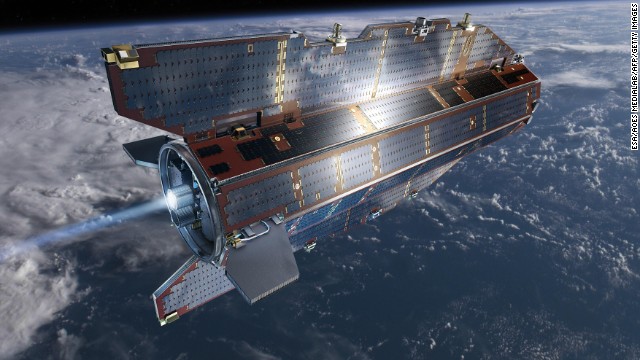
Satellite will fall back to Earth, but where?
STORY HIGHLIGHTS
- A European satellite fell Saturday an estimated 8 miles, space agency says
- Scientist: It will have its final entry into the atmosphere in “less than 2 days”
- Nobody knows exactly where its fragments will hit Earth, though it’s being tracked
- It was powered by solar panels and a lithium-ion battery
Earthlings, you’re safe for another day or two.
After that, you might want to watch your head.
The 2,000-pound Gravity Field and Steady-State Ocean Circulation Explorer — a European Space Agency satellite known shorthand as GOCE– continued its freefall Saturday, dropping an estimated 13 kilometers (8 miles) over the course of the day. That’s a pretty good clip, but the former orbiter still has a long ways to go: It started the day at an altitude of about 160 kilometers, said ESA’s Christoph Steiger earlier Saturday.
“Final entry into the atmosphere (is) probably less than two days away,” Steiger added.
Where will the satellite — or more accurately, fragments thereof — hit? Nobody really knows.
An ocean somewhere is the best bet, with unpopulated areas on land also a good possibility. Still, there remains a chance that pieces may hit where people live. The space agency has promised on its website that potential landing spots will be narrowed down as GOCE gets closer to reentry.
That hadn’t happened yet as of Saturday afternoon, though anyone can track the satellite via an ESA website.
One good thing is that humans on Earth needn’t worry about is remnants of a nuclear powered or similarly fueled object. While that’s the case for some other satellites, GOCE had been powered by solar panels and not-your-average lithium-ion battery.
That battery ran out of juice on October 21, meaning it lasted longer — since its 2009 launch — than most expected.
GOCE’s altitude was lowered to about 139 miles, lowest of any research satellites, to improve the accuracy of the information being gathered, ESA said on its website.
On November 4, ESA reported that the satellite was orbiting the Earth at 119 miles and the rate of descent would increase significantly in coming days.
That’s proven true to form, though signals have continued to come in despite what Steiger called “extreme environmental conditions” — in other words, the kind of stuff that happens to any falling object as it plummets toward the Earth.
To this point, the scientist added: “Recently, we have noticed a significant temperature increase in several areas of the spacecraft, arguably linked to GOCE encountering a more and more dense atmosphere as its orbit keeps dropping.”
The five-meter long GOCE was a cumulative effort involving 45 companies from some 13 European nations.
When it strikes Earth, that will officially end its mission to map variations in the Earth’s gravity in 3D, provide ocean circulation patterns and make other measurements.
In March 2011, the European Space Agency added another role — as the “first seismometer in orbit” — when it detected sound waves from the massive earthquake that struck Japan.


Leave a reply